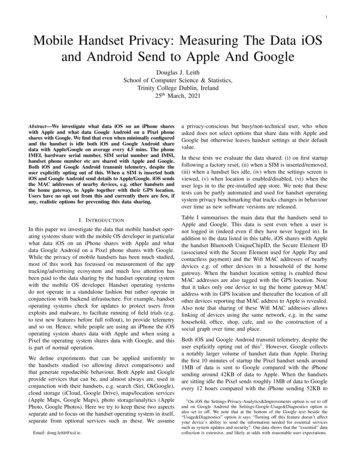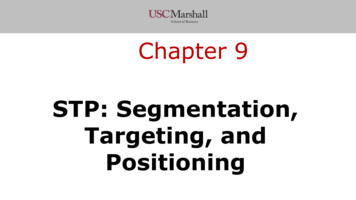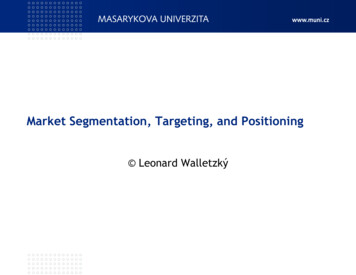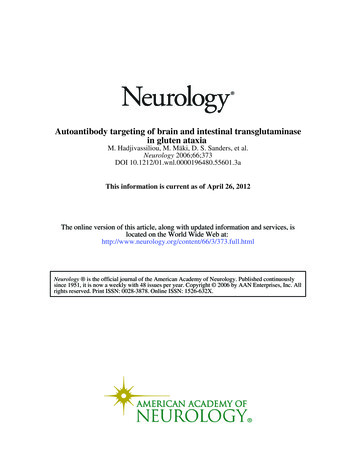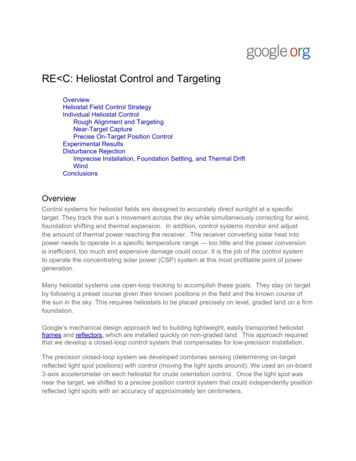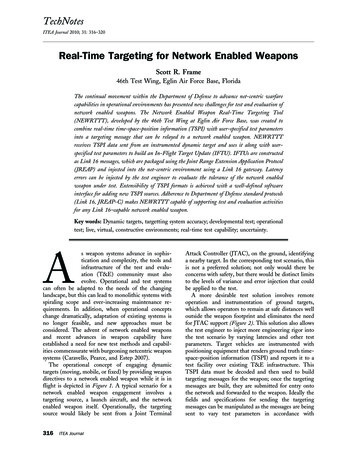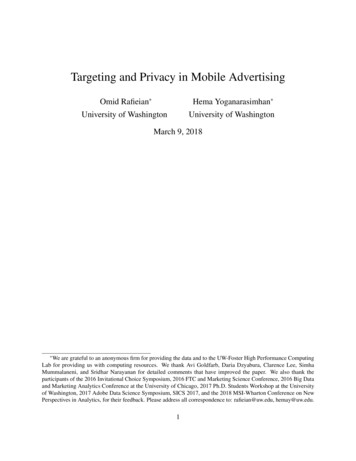
Transcription
Targeting and Privacy in Mobile AdvertisingOmid Rafieian Hema Yoganarasimhan University of WashingtonUniversity of WashingtonMarch 9, 2018 We are grateful to an anonymous firm for providing the data and to the UW-Foster High Performance ComputingLab for providing us with computing resources. We thank Avi Goldfarb, Daria Dzyabura, Clarence Lee, SimhaMummalaneni, and Sridhar Narayanan for detailed comments that have improved the paper. We also thank theparticipants of the 2016 Invitational Choice Symposium, 2016 FTC and Marketing Science Conference, 2016 Big Dataand Marketing Analytics Conference at the University of Chicago, 2017 Ph.D. Students Workshop at the Universityof Washington, 2017 Adobe Data Science Symposium, SICS 2017, and the 2018 MSI-Wharton Conference on NewPerspectives in Analytics, for their feedback. Please address all correspondence to: rafieian@uw.edu, hemay@uw.edu.1
AbstractMobile in-app advertising is growing in popularity. While these ads have excellentuser-tracking properties through mobile device IDs, they have raised concerns amongprivacy advocates. There is an ongoing debate on the value of different types of mobiletargeting, the incentives of ad-networks to engage in behavioral targeting and share userdata with advertisers, and the role of regulation. To answer these questions, we proposea modeling framework that consists of two components – a machine learning frameworkfor predicting click-through rate and a stylized analytical framework for conductingdata-sharing counterfactuals. Using data from the leading in-app ad-network of anAsian country, we show that our machine learning model improves targeting ability by17.95% over no targeting. These gains mainly stem from behavioral information and thevalue of contextual information is relatively small. Stricter regulations on user-trackingsubstantially shrink the value of behavioral targeting. Counterfactuals show that thetotal advertisers’ surplus grows with more granular information-sharing between thead-network and advertisers. However, there is heterogeneity among advertisers intheir preferred level of data-sharing. Importantly, the ad-network’s revenues are nonmonotonic, i.e., it prefers to not share behavioral information with advertisers. Thus,the ad-network may have natural incentives to preserve users’ privacy without externalregulation.Keywords: mobile advertising, machine learning, auctions, behavioral targeting, privacy2
11.1IntroductionMobile Advertising and TargetingSmartphone adoption has grown exponentially in the last few years, with more than two billionpeople owning a smartphone today (eMarketer, 2017a). The average smartphone user now spendsover 2.8 hours per day on her phone. In addition to making phone calls and browsing, users spend asignificant amount of time on native applications, popularly known as “apps” (Perez, 2015; Chaffey,2017). As mobile usage has surged, advertisers have followed the eyeballs. In 2016, mobile ad spendovertook desktop ad spend for the first time by generating over 106 billion dollars in revenuesworldwide, which accounts for 55.7% of digital advertising revenues (eMarketer, 2017b).The rapid growth of mobile advertising partly stems from an ad format unique to the mobileenvironment – “in-app ads” or ads shown inside apps. In-app advertising now generates over 72billion dollars worldwide and owes its increasing popularity to two factors (AppAnnie, 2017). First,with the proliferation of free apps, in-app advertising has become a mainstream app monetizationstrategy (Hollander, 2017). Second, in-app ads have excellent tracking and targeting properties,allowing advertisers to “behaviorally” target their ads. Advertisers and ad-networks have access toa unique device ID associated with the mobile device that they can use for tracking and targetingpurposes, referred to as IDFA (ID For Advertisers) in iOS devices and AAID (Android AdvertiserID) in Android devices. This device ID is highly persistent and remains the same unless activelyre-set by the user. This allows advertisers to stitch together user data across sessions, apps, and evenother advertisers (Edwards, 2012).1While the advertising industry has lauded the trackability of in-app ads suggesting that theycreate value for advertisers by allowing them to target the right consumer, consumers and privacyadvocates have derided them citing privacy concerns. Bowing to pressure from consumers, mobilephone makers have started taking steps to limit user-tracking. First, in 2012, Apple went fromUDID (Unique Device ID) to IDFA. The latter is user re-settable (much like a cookie), whereasthe former was a fully persistent unique device ID that could not be erased by users under anycircumstance (Stampler, 2012). In 2013, Android made a similar move from Android ID to AAID(Sterling, 2013). While this caused some consternation among advertisers, it nevertheless did notupend the mobile advertising ecosystem since few users actively re-set IDFAs on a regular basis.However, in mid-2016, Apple took a much stronger stance in support of privacy by allowing usersto completely opt out of tracking through LAT (Limit Ad Tracking), wherein a user can simply1This is in contrast to browser-based mobile ads, which have poor tracking properties since third-party cookies don’twork in many browsers (e.g., Safari, the most popular browser) and hence tend to be poorly targeted (Sands, 2015).1
switch off tracking indefinitely (Gray, 2016).2 This makes it impossible for advertisers to target ads,attribute conversions, or re-target and re-engage users. Studies show that nearly 20% of iOS usershave already chosen to opt into LAT, raising significant concerns among advertisers about the futureof targeted mobile advertising (Seufert, 2016).This tension between behavioral targeting and privacy in mobile advertising is part of a largerongoing debate over consumer tracking and privacy in digital contexts. Advertisers argue thattracking allows consumers to enjoy free apps and content, and see relevant ads, whereas regulatorsand consumers demand higher privacy, control over their data, and limits on data-sharing amongfirms. In mid-2016, the European Union signed the General Data Protection Regulation (GDPR)agreement, which will go into effect in May 2018 (Kint, 2017). Under the new regulations,consumers will have to opt into (rather than opt out of) behavioral targeting and will need to giveexplicit permission for their data to be shared across firms. Violators will be fined up to 4% oftheir global revenues. In the US, under the Obama administration, the Federal CommunicationsCommission (FCC) adopted legislation to limit tracking and data-sharing among large ISPs. Theadvertising industry lobbied against these rules, and scored a win when these rules were recentlyrelaxed under the Trump administration (Fung, 2017). Nevertheless, polls show that over 92%of US consumers believe that the government should ban tracking and sharing of consumer data(Edwards-Levy and Liebelson, 2017).Even as this debate rages on, we do not have a good understanding of how tracking and datasharing affect advertisers’ ability to target, the incremental value of different types of informationon improving targeting accuracy, and the incentives of different players in the mobile advertisingindustry. Lack of clear empirical analyses of these issues hampers our ability to have an informeddiscussion and to form policy on these issues.1.2Research Agenda and ChallengesIn this paper, we are interested in three key research questions related to targeting and privacy in themobile ecosystem. First, what is the value of different pieces of information in improving targeting accuracy? Weare specifically interested in the relative value of contextual vs. behavioral information. Theformer quantifies the context (when and where) of an impression, and the latter constituteshistoric data on an individual user’s past app usage, ad exposure, and ad response. Contextualinformation is privacy preserving whereas behavioral information is based on user-trackingand therefore impinges on user-privacy. Further, we want to quantify the total improvement in2When a user turns on LAT, her IDFA simply shows up as a string of zeroes to the advertisers. Thus, all the consumerswho have opted into LAT are visible as one large ghost segment to ad networks.2
targeting effectiveness that can be achieved when all types of information are used. Second, how would stronger privacy regulations affect the ad-network’s ability to target? If thead-network were to lose the ability to do user-tracking through device IDs (e.g., through blanketadoption of LAT or government regulation), to what extent would its targeting ability suffer? Finally, we are interested in examining the relationship between the advertisers’ targeting abilityand platform revenues. Does the ad-network have an incentive to share targeting data withadvertisers and thereby enable targeted bidding? If yes, is there an optimal level of data-sharing?To build a unified and scalable framework to answer these questions, we need to overcomethree key challenges: 1) achieve high predictive accuracy, 2) have sufficient randomness in the datagenerating process, and 3) tie prediction to incentives. We discuss each of these in detail below.First, to accurately quantify the value of different pieces of targeting information, we need tobuild a click prediction model with the best possible out-of-sample accuracy. That is, the modelshould be able to accurately predict whether a targeted impression will lead to a click or not.Indeed, models with poor predictive ability will lead to downward bias and noise in the estimates ofthe value of information. In the marketing literature, the commonly used approach to predictivemodeling involves making functional form on the relationship between the outcome variable and theindependent variables. From a statistical perspective, this can be thought of as parameter inferencegiven a functional form. Implicitly, this allows the researcher to constrain the model space as wellas the extent of interactions between variables. While this simplifies the problem that we need tosolve, it also compromises the model’s predictive ability because the researcher cannot intuit theappropriate functional-form a priori and indeed the correct functional form is likely to be extremelycomplex. Instead, the correct approach to building models with high predictive accuracy can beformally thought of as function evaluation. This allows for full flexibility in the interactions betweenvariables as well as function-specification. However, this is also a much harder statistical learningproblem to solve, especially when we have a large number of features.3 Indeed, this problem isNP-hard and we need to turn to machine learning methods built for function evaluation to solve it.Second, we need sufficient randomness in the data generating process for our predictive model tobe applicable to counterfactual scenarios. Consider a hypothetical scenario where an ad is targetedto only women in the observed data. A well-specified machine learning model can generate accuratepredictions of womens’ CTR for this ad. However, it cannot tell us how men will respond to this3We have around 160 features. So from a function evaluation perspective, we have to explore all the non-linearcombinations of these features. This problem is exacerbated by the fact that we don’t know which of these variablesand which interaction effects matter, a priori. Even if we try to constrain the model to pairwise interactions, we wouldbe working with 12960 variables. Thus, it is not feasible to come up with the best non-linear specification of thefunctional form either by manually eyeballing the data or by including all possible interactions.3
ad since we never observe mens’ response to it. Thus, if we want to use our predictive models togenerate counterfactual predictions of CTRs for alternative targeting strategies, we need the modelto have been trained on data that is not too narrowly targeted. Third, we need an underlying modelof strategic interactions that can quantify effect of different targeting strategies on ad-network andadvertiser revenues. Without an economic model of market players which puts some structure onrevenues, we cannot make any statements on how ad-networks or advertisers’ incentives to targetand/or the extent to which these incentives are aligned.Thus, we need a unified modeling framework that coherently combines predictive machinelearning models with prescriptive economic models in order to overcome these challenges andanswer our research questions of interest.1.3Our ApproachWe present a modeling framework consists of two main components – (1) A machine learningframework for Click-Through Rate (CTR henceforth) prediction, and (2) a stylized analyticalmodel to characterize the ad-network and advertisers’ profits under different data-sharing (andcorresponding targeting) scenarios. The machine learning part consists of two modules – (a) a feature generation framework and (b) alearning algorithm. The former relies on a set of functions to generate a large number of featuresthat capture the contextual and behavioral information associated with an impression. Ourfeature functions can be aggregated over different lengths of history preceding the impression,thereby allowing us to capture the impact of long-term, short-term, and ongoing session-levelhistory. Using these functions, we generate a total of 161 features. These serve as input variablesinto a CTR prediction model, which forms the second module. We use the Extreme GradientBoosting algorithm (XGBoost) proposed by Chen and Guestrin (2016), a fast and scalableversion of boosted regression trees, to train and infer the optimal the CTR prediction model. Ourcontribution here primarily lies in our feature generation framework that generates informativeand theory-driven feature functions for the mobile in-app advertising ecosystem. The second component of our model is a framework for conducting data-sharing counterfactuals.We develop a stylized analytical model of data-sharing that characterizes the ad-network’srevenue and advertisers’ profit under different-levels of data-sharing. We analytically provethat while the total surplus in the system increases with more granular data-sharing and targeted bidding, the ad-network’s revenue can go in either direction when we do not imposeany functional form assumptions on the distribution of match values. We then combine thisanalytical model with the machine-learning targeting models developed in the first moduleto derive empirical estimates of the ad-network’s revenue and advertisers’ surplus under four4
counterfactual data-sharing scenarios.We apply our framework to one month of data from the leading mobile advertising ad-networkfrom a large Asian country. The scale and scope of the data are large enough to provide realisticsubstantive and counterfactual results. For our analysis, we sample over 27 million impressions fortraining, validation, and testing, and use another 146 million impressions for feature generation.A notable feature of our data is the extent of randomization of ads over impressions. Unlikeother advertising ecosystems, in our setting ads are shown over a large variety of impressionsand impressions can be allocated a wide variety of ads, i.e., the targeting/match between ads andimpressions is quite low. Three unique structural aspects of the marketplace contribute to thisfeature. First, the ad-network uses a quasi-proportional auction mechanism, where the allocationrule is probabilistic rather than deterministic (Mirrokni et al., 2010). Thus, the highest scoringbidder does not always win. Second, the ad-network supports limited targeting and the extent oftargeting in the ad-network is low. Third, the ad-network uses the average past CTR of an advertiserin the ad-network to generate the advertiser’s score (bid CTR). So the score is a weak predictorof the likelihood of a click. Together these lead to significant randomness in the allocation of ads toimpressions. In principle, we do not need any randomness in the data generating process to build agood predictive model of clicks. All the substantive results from the machine learning module of ourmodel are valid as long as the joint distribution of features and clicks is the same in the training andtest data-sets. However, when we move to counterfactuals, we need our machine learning to be ableto predict the CTR of not just the ad actually shown in an impression, but of all ads competing forthat impression. In this case, having seen a large variety of ad-impression matches greatly enablesour analysis. Thus, the second set of counterfactual results would not be possible if ads were notsufficiently randomized over impressions in the observed data.1.4Findings and ContributionWe now describe our main findings. Our results can be categorized into two groups – a first set ofsubstantive results from the machine learning component of the model, and a second set of resultsfrom the what-if analysis that combines the analytical model of data-sharing with the machinelearning targeting model.We start with the substantive results from the machine learning model. First, we show that ourfull targeting model (that uses all the 161 features) can significantly improve advertisers’ targetingability. Our model leads to a 17.95% improvement in targeting ability compared to the base caseof no targeting, as measured by Relative Information Gain (RIG). We also show that XGBoostoutperforms other commonly used methods such as least squares, logistic regression, LASSO,single regression trees, and random forests. More broadly, models that employ data partitioning5
(e.g., tree-based algorithms) perform better than other model classes.Second, we quantify how different pieces of information contribute to the efficacy of ourtargeting model. We first consider the relative value of contextual and behavioral information. Wefind that pure behavioral targeting (without using any contextual information) leads to a 12.14%improvement in RIG compared to the baseline model, whereas pure contextual targeting (withoutusing any behavioral information) provides only 5.25% improvement in RIG. Taken together, ourresults can help managers gain intuition on when and where consumers click, which consumersclick, and what types of ads they click on and estimate the benefits of targeting based on differentfeatures.Third, we examine the impact of strengthening privacy regulations on the ad-network’s abilityto target. We consider a scenario where user-tracking through device IDs is banned (e.g., throughblanket implementation of LAT) and the ad-network has to rely on the second-best user-identifier,IP address. In this case, the performance of our full targeting model drops to 13.38%. Moreover, wefind that the relative value of contextual vs. behavioral information flips, i.e., contextual featurescontribute more to the model’s performance than behavioral features based on IP. This suggeststhat behavioral targeting without a reliable user-identifier is not very effective. Next, we examine ifthe loss in behavioral information can be mitigated if we have longer user histories. Surprisingly,the efficacy of IP-based behavioral targeting worsens with the length of history. Thus, using longerhistories can actually be counter-productive with weak identifiers.We further investigate why IP is a weak identifier. Note that both IP and device IDs suffer fromthe problem of potentially identifying one user as multiple users because the user-identifier can bere-set. In the case of IP, this problem is more severe because it can be automatically re-set whereasdevice-IDs like AAID have to be actively re-set by the user. While this is one source of the problem,IP has a more serious flaw – that of incorrectly ident
Mar 03, 2018 · upend the mobile advertising ecosystem since few users actively re-set IDFAs on a regular basis. However, in mid-2016, Apple took a much stronger stance in support of privacy by allowing users to completely opt out of tracking t
